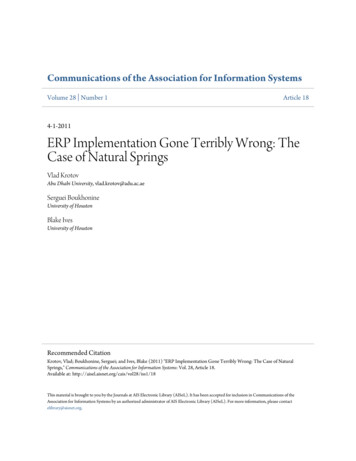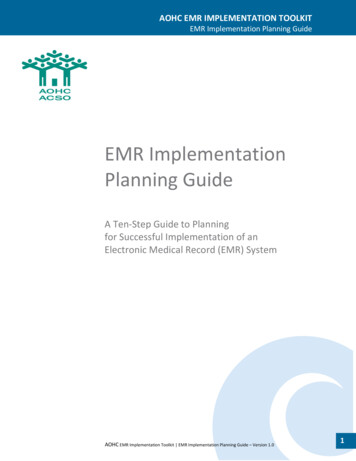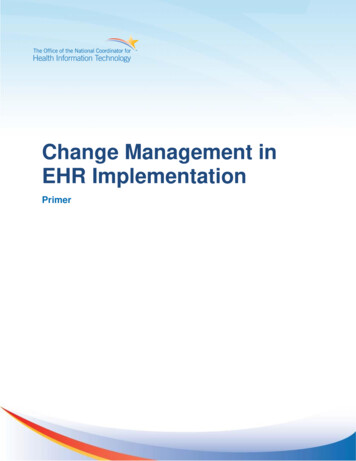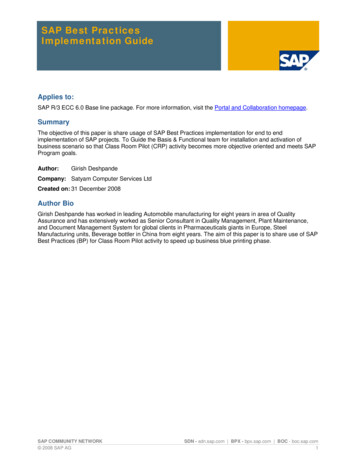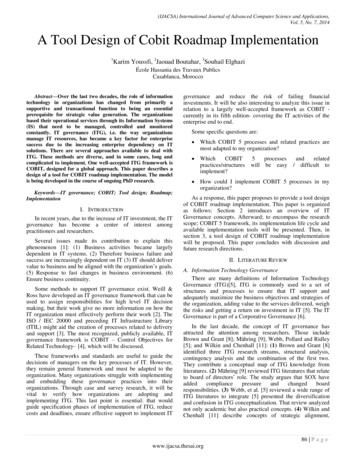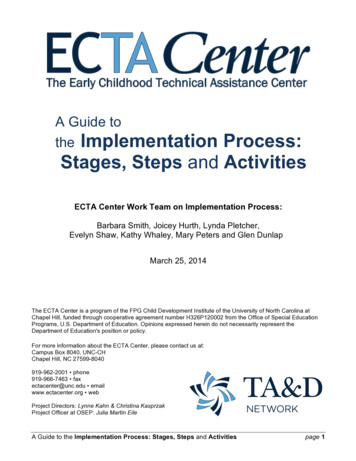
Transcription
SC I E N CE CHT S V I S I O N STENOLOGYHIG28EARCH HIGHLRaimo HyötyläinenESImplementation ofinformation systemsas an organisationalconstruction RISBN 978-951-38-7958-7 (Soft back ed.)ISBN 978-951-38-7959-4 (URL: http://www.vtt.fi/publications/index.jsp)ISSN-L 2242-119XISSN 2242-119X (Print)ISSN 2242-1203 (Online)Implementation of information systems as an organisational constructionIn this study, the focus is on the implementation process of informationsystems, which is approached by means of a systems analysis with itsstrong organisational emphasis. The intent is to create theoretical andconceptual research models as well as practical solutions. The objectiveis to use various research approaches to show the possibilities of aconstructive research and development approach in creating organisational constructions in the planning and implementation of informationsystems and their practical development solutions, as well as in theformation of new theoretical and conceptual knowledge. In this study,consideration is given to a constructive approach that is close to thepragmatic research and development tradition. The main aim of thestudy is to determine the new kind of planning and implementationsystem and its major relations with its organisational constructions,emphasising practical applicability.VTT SCIENCE 28Implementation of information systems as anorganisational construction
VTT SCIENCE 28Implementation of informationsystems as an organisationalconstructionRaimo Hyötyläinen
ISBN 978-951-38-7958-7 (Soft back ed.)ISBN 978-951-38-7959-4 (URL: http://www.vtt.fi/publications/index.jsp)VTT Science 28ISSN-L 2242-119XISSN 2242-119X (Print)ISSN 2242-1203 (Online)Copyright VTT 2013JULKAISIJA – UTGIVARE – PUBLISHERVTTPL 1000 (Tekniikantie 4 A, Espoo)02044 VTTPuh. 020 722 111, faksi 020 722 7001VTTPB 1000 (Teknikvägen 4 A, Esbo)FI-02044 VTTTfn. 358 20 722 111, telefax 358 20 722 7001VTT Technical Research Centre of FinlandP.O. Box 1000 (Tekniikantie 4 A, Espoo)FI-02044 VTT, FinlandTel. 358 20 722 111, fax 358 20 722 7001Kopijyvä Oy, Kuopio 20132
Implementation of information systems as an organisationalconstructionRaimo Hyötyläinen. Espoo 2013. VTT Science 28. 171 p.AbstractIn this study, the focus is on the implementation process of information systems,which is approached by means of a systems analysis with its strong organisationalemphasis. The intent is to create theoretical and conceptual research models aswell as practical solutions. The objective is to use various research approaches toshow the possibilities of a constructive research and development approach increating organisational constructions in the planning and implementation of information systems and their practical development solutions, as well as in the formation of new theoretical and conceptual knowledge. In this study, consideration isgiven to a constructive approach that is close to the pragmatic research and development tradition. The main aim of the study is to determine the new kind of planning and implementation system and its major relations with its organisationalconstructions, emphasising practical applicability.In this study, the treatment of the implementation process of information systems in a user organisation is tackled in a new way. The main argument in thisstudy is that it is not only a question of changing the view of renovating informationsystems in a more user friendly manner. Instead, it is a question of a profoundchange in the research and development approach for researching and developing information systems. The main point of view is to look at the implementationof information systems as an organisational construction, comprising learning andinnovation processes where different actors in the organisation are involved andinfluence the actions adopted.In this study, it is emphasised that there is the need to renew knowledge concepts from the premises of positivism and interpretivism towards constructiveapproaches, with new knowledge concepts based on critical realism approaches.Furthermore, the study develops an organisational construction process-orientedframework for the implementation issue. This means that the implementation ofinformation systems is seen to be a gradual organisational process in which thelearning and innovation steps taken by the applying organisation and its differentactors play a crucial role for the success of the implementation process.In this study, it is shown that the implementation of an information system in anorganisation is a complicated process, which involves issues involving technicaland organisational changes. This forms an innovation design dilemma. From theviewpoint of successful change, technical change should be seen as an organisational construction process. The organisational construction process can becomean obstacle to successful implementation and, thus, endanger achievement of theset objectives.3
After the strategic and management process, the implementation of informationsystems consists of three main activities. These are: planning activity, implementation activity, and use and development activity. In the planning, it is normally aquestion of an activity with the objective of a new solution compared to the formersituation. That can be seen as an innovation from the wiewpoint of the user–organisation. The information system applied is the main part of this innovation.Besides, organisational construction processes and new action modes are to be apart of this innovation solution. Through the implementation activity, these innovation elements are tried out in practice. The other dimension is organisational andtechnical development, which describes the effort to gain the full use of the potential of the innovation steps.In this study, the planning and implementation steps in four cases are described and analysed. It is shown which method can be used to implement and useinformation systems. In each case, the following points will be described and analysed: the starting points; the choice and definition of objectives; the analysis; thedevelopment work; and the assessment of results.As the result of the case analysis, an analysis of all the case results is made,and management aspects are assessed. The basis is the life–cycle framework.The path models comprise a strategy and management model, a requirementsmodel, an implementation model, and a development model. There are interdependencies between the path models. These refer to the objectives and hierarchical action trees, change management, organisational changes, and investmentmodels. Furthermore, as the summary, the decision for growth and change wasassessed. The points are: the challenges of growing firms, the importance of implementation, the management practices, and competence development, whichare analysed and assessed in connection to the implementation of informationsystems, as well as to strategic and organisational changes.In this study, there is an implication of how to solve the innovation design dilemma. Different solution models are considered. The study presents solutions for themanagement of the implementation process of information systems. As the basis,the planning choice of technical change is analysed. As the theoretical result of thisstudy, the organisational construction model for the planning and implementationprocess is analysed and assessed. The organisational learning approach completesthe organisational construction model with learning dimensions.KeywordsInformation system, implementation, organisation, innovation design dilemma, theoretical approaches, information and knowledge concepts, constructive approaches and models, constructive methods, case solutions4
PrefaceIn this study, the focus is on the implementation process of information systems,which is approached by means of systems analysis, with its strong organisationalemphasis. The intent is to create theoretical and conceptual research models, aswell as practical solutions. The objective is to use various research approaches toshow the possibilities of a constructive research and development approach increating organisational constructions in the planning and implementation of information systems and their practical development solutions, as well as in the formation of new theoretical and conceptual knowledge.This kind of problem setting has interested us for several years, beginning fromthe second half of the 1980’s. We have developed and applied research and development models in the case of enterprise projects. The method developed iscalled a development cycle method, which is based on case studies and is, by itsnature, a constructive research and development method. The main features ofthe method are a development cycle, teamwork, and modelling. The developmentof our constructive approach and methodology has been based on developmentalresearch and experiments. Our method aims to construct solutions in practice. Wehave further developed constructive methods in connection to information systemsstudies.I have been continuously engaged in research and development projects concerning enterprises for more than twenty five years. First, my focus was mainly onthe planning and implementation process of production and technical changes.We have studied these changes in different environments, based on case studiesin which several companies have participated during these years. A lasting themein our studies has been the question of both research and development activities,and of their relation to the change and development processes going on in companies. That has, to a great extent, labelled our approach. Since the late 1990 s,we have gone to do research and development on the planning and implementation process of information systems.The case descriptions to be presented in this study are based on a wideranging research programme that was carried out from the end of 1999 to thebeginning of 2004. The name of the programme was The Developing Management of Technology – Implementation of an Enterprise Resource Planning Systemas an Organisational Learning Process. The programme and its major topics arerelated to the Scandinavian tradition, where user- and work-centred approaches5
have as strong position, as well as participating approaches in general. The programme itself was implemented in a Finnish business environment. VTT TechnicalResearch Centre of Finland was a major research organisation and was alsoresponsible for the whole programme at the same time. There were two Finnishresearch partners in the programme. One was the University of Turku and theother was the University of Jyväskylä. Professor Kalle Lyytinen was also activelyparticipating in the formulating of the programme from its very beginning. He wasthen working at the University of Jyväskylä.As a preliminary result of the programme, a book was published in Finnish in2001, based on the collection of different articles. The book then published wascalled ERP Implementation in Small and Medium-sized Enterprises: From Technology Push to the Management of Knowledge and Expertise (Kettunen and Simons (eds.), 2001). The major topics covered were, for example, the implementation of information systems, enterprise resource planning and its systems, changes of activity and learning at work within an information systems environment, thestrength and limits of process thinking, and the methods supporting the development of the information system.In this study, the treatment of the implementation process of information systems in a user organisation is tackled in a new way. The main argument in thisstudy is that it is not only a question of changing the view of renovating informationsystems to be more user friendly. Instead, it is a question of a profound change inthe research and development approach for researching and developing information systems. The main point of view is to look at the implementation of information systems as an organisational construction comprising learning and innovation processes, where different actors in the organisation are involved and influence the actions adopted.I am indebted to many my colleagues at VTT and to the two universities whoparticipated actively in the research programme and its successful execution.Altogether, the researchers in the programme formed a very inspirational atmosphere for stimulating new ideas and topics during programmes implementation. Iam also grateful to all the companies and their personnel who participated in theprogramme, their favourable attitude and hearty devotion to advance the implementation of new practices and systems.I stand in awe with thanks to the following persons who participated in our research programme: Magnus Simons, Iiro Salkari, Petri Kalliokoski, Jari Kettunen,Inka Lappalainen, Tapani Ryynänen and Iris Karvonen from VTT. I give manythanks to four professors who participated in our common research and development programme on the implementation process of information systems in different contexts. The professors are: Professor Kalle Lyytinen and Professor TimoKäkelä from the University of Jyväskylä, and Professor Markku Nurminen andProfessor Eija Karsten from the University of Turku.Espoo, January 2013Raimo Hyötyläinen6
ContentsAbstract . 3Preface . 51.Introduction. 111.1 Starting points of the study. 111.2 Focus and aim of the study . 141.3 Research approach and setting of the study . 161.4 Research method . 171.5 Structure of the study. 192.Theoretical aspects of information systems . 212.1 Action research tradition . 212.2 Towards new information and knowledge concepts. 222.3 Towards use-oriented planning and implementation practices . 242.4 Summary: nature of research and development . 273.Approaches for researching information systems . 293.1 Research approaches and model . 293.1.1 The premises of positivism . 313.1.2 Interpretivism and changed problem formulation . 323.1.3 The tradition of pragmatism . 323.1.4 The constructive approach and solution models . 333.1.5 The realist approach and its knowledge concept . 343.2 Summary: a constructive research and development model . 353.3 A basis for hypothesis formation. 364.The innovation design dilemma and its implication . 384.1 Design and adoption of information systems . 384.2 Innovation design dilemma. 394.3 Factors of the innovation design dilemma . 404.4 Development mechanisms of the implementation process ofinformation systems . 434.5 Summary: implementation as an organisational process . 457
5.Constructive implementation steps for information systems . 475.1 Phase model of the planning and implementation process . 475.2 Development cycle method . 515.2.1 Start of collaboration . 535.2.2 Analysis. 545.2.3 Choice and definition of objectives. 555.2.4 Development work: planning and testing. 565.2.5 Adoption of solutions. 565.3 Summary: development points in cases. 576.Case A: development of business strategy and operationsmanagement. 596.1 Starting points . 596.2 Start of collaboration in Case A . 606.3 Analysis . 616.4 Choice and definition of development objectives . 626.5 Development work . 636.6 Assessment of results. 707.Case B: development of subcontracting strategy and informationsystems needs . 717.1 Starting points . 717.2 Start of collaboration in Case B . 727.3 Analysis . 727.4 Choice and definition of objectives . 737.5 Development work . 767.6 Assessment of results. 818.Case C: development of business strategy and productionoperations . 828.1 Starting points . 828.2 Start of collaboration in Case C . 838.3 Analysis . 838.4 Choice and definition of objectives . 848.5 Development work . 858.6 Assessment of results. 909.Case D: continuous development of information systems . 919.1 Starting points . 919.2 Start of collaboration in Case D . 939.3 Analysis . 939.4 Choice and definition development objectives. 959.5 Development work . 969.6 Assessment of results. 1038
10. Analysis of the case study results and change management . 10510.1 Life-cycle framework . 10510.2 Path models . 10610.2.1 Strategy and management model . 10910.2.2 Requirements model . 11010.2.3 Implementation model . 11210.2.4 Development model . 11310.3 Mutual interdependencies of path models. 11410.3.1 Objectives and hierarchical action trees . 11410.3.2 Change management . 11410.3.3 Organisational changes . 11510.3.4 Investment models. 11610.4 Summary: decision for growth and change . 11610.4.1 Challenges of growing firms . 11610.4.2 Importance of implementation . 11710.4.3 Management practices . 11810.4.4 Competence development . 11911. Solutions for innovation the design dilemma. 12011.1 Planning choice of technical change. 12011.2 Organisational construction model for the planning andimplementation process . 12111.3 Organisational learning approach . 12411.4 Summary: organisational prosesses . 12512. Conclusions . 12712.1 Summary of the study . 12712.2 Research questions and results . 12912.2.1 Research frameworks in information systems development . 13012.2.2 Innovation design dilemma and its solutions . 13212.2.3 Constructive research and development . 13312.3 Evaluation of the study results. 13412.4 Future research needs . 136References. 1379
10
1. Introduction1.Introduction1.1Starting points of the studyIt is not so easy to distinguish whether it is a question of data, information orknowledge, when we are discussing information systems and their implementationprocess. Information systems can be approached through a technological or socialperspective. The technological perspective emphasises information gathering andanalysis functions. The social perspective is rooted in a view of knowledge as asocial and organisational construction (Checkland and Holwell, 1998; Prieto andEsterby, 2006; cf. Luhmann, 1995; Berger and Luckmann, 1996).The main argument in this study is that there is a big difference, in whether welook at information systems and their management from the angle of data, information, or knowledge (Kettinger and Li, 2010). The data perspective is normallyconnected to data modelling and its methods for advancing information systems.But it is not all clear what is data. As Hirschheim et al. (1995) present, data anddata modelling are always tightly linked to historical processes in which differentusers read and interpret data and meanings. According to them, there is no universal meaning that can be associated with object system representation, whichgoes beyond these processes bound to different concrete contexts. As they emphasise, there are different conceptual and philosophical foundations, within whichdata modelling is seen from different angles contrary to each other.In this study,the treatment of the implementation process of information systems in a userorganisation is tackled in a new way. The main argument in this study is that it isnot only a question of changing the view of renovating information systems to bemore user-friendly. Instead, it is a question of a profound change in the researchand development approach for researching and developing information systems(Gregor, 2006). The main point of view is to look at the implementation of information systems as an organisational construction comprising learning and innovation processes, where different actors in the organisation are involved and influence the actions adopted (March and Smith, 1995; Nonaka et al., 1996; Lewis etal., 2005).In this study, it is emphasised that there is a need to renew knowledge concepts, from the premises of positivism and interpretivism towards constructiveapproaches, with new knowledge concepts, based on critical realism approaches11
1. Introduction(cf. Hevner et al., 2004; Gregor, 2006). Furthermore, the study develops an organisational construction process–oriented framework for the implementation issue.This means that the implementation of information systems is seen to be a gradualorganisational process, where the learning and innovation steps taken by theapplying organisation and its different actors play a crucial role in the success ofthe implementation process.The information and knowledge perspective brings into view the special characteristics of information systems. It emphasises the organisational constructionprocesses of applying information systems in an organisation. Checkland andHolwell (1998) discuss organisational transformation processes, based on actionresearch premises. They see that persons in an organisation continuously createand recreate social reality in social interaction. That implies that information systems are wider systems than mere information technologies. Human beings arealways directly communicating with others, not only through technological systems. Through these co-operation and organisational action patterns, persons inan organisation also give meanings to information systems (cf. Brown and Duguid,1991; Weick, 1995; Choo, 1998; Rowlands, 2009). The systems understood in thisway are organisational learning and innovation systems, where personalknowledge and know-how have in an important role (Kumar and Van Hillegersberg, 2000; Mao and Palvia, 2008). Organisational networks are, largely,acknowledged to be most important for information and knowledge formation andevolution (Sproull and Kiesler, 1991; Sher and Lee, 2004; Choi et al., 2011). AsMacdonald (1998) states, information and knowledge once acquired and usedmeld with personal skill and experience, which can be exploited to the individual’sadvantage, but also to create a change in the organisational context of informationsystems (cf. Sparrow, 1998).Information and knowledge perspectives together make a clear difference between information systems and information technology. Information andknowledge aspects can be seen to mark the organisational need to manage theuse of information technology in relation to an organisation’s activities and intentions (Nonaka et al., 1996; Checkland and Holwell, 1998). It could be seen to be aquestion of information technology and management. In this study, the main question is how information systems can best be organisationally applied and how theyshould be managed (cf. Markus, 2004).Besides, it has raised a question of how to research information systems andtheir implementation process. Mumford et al. (1985) edited the book on ResearchMethods in Information Systems, where different researchers handled questions ofhow to acquire knowledge of information systems and change processes in thiscontext. Different authors in the book bring forth different aspects of researchmethodologies and methods to get knowledge concerning information systemsand their implementation and use (cf. Russo and Stolterman, 2000; Gregor, 2006).Based on the treatment above, we can say that there are fundamental sets ofassumptions about the nature of the world and how one can obtain knowledge ofit. These ontological and epistemological assumptions are of high importance forthe planning and implementation process of information systems, as well as for12
1. Introductionthe use of systems (Hirschheim et al., 1995). In this study, we limit our discussionto the planning, implementation, and use of information systems in an organisation. We mainly speak about the implementation process, but in that connectionwe touch upon planning and use issues as well.We share the widely accepted view that information systems are seen to be afactor that extensively and deeply affects business activities and organisationalpractices (Kearns and Lederer, 2004; Bhatt et al., 2010). As it is normal to suppose, it is seen that information systems can relatively easily be implemented.Business processes and organisational practices will adapt to the demands of newinformation systems and their technologies. These kinds of approaches have beenproposed by many textbooks, such as Edwards et al., (1995), Thorp (1998), Curtis(1998), Cassidy (1998), and Laudon and Laudon (2000). Davenport (1993), earlier, was also in the same line. However, most researchers use other than normaltextbooks (e.g. Lee, 1999; O Donovan and Roode, 2002; Wu et al., 2007; Bhatt etal., 2010). Based on that, we can state that the implementation of informationsystems within an organisation is a process that is difficult to handle, both in termsof practice and theory. It is widely acknowledged that the implementation of information systems is a sticky organisational problem (cf. von Hippel, 1998;Hyötyläinen, 1998; Baumard, 1999; Irani, 2002; Szulanski, 2003). In practice,companies have great difficulty in implementing information systems, and especially in fully using all th
The book then published was called ERP Implementation in Small and Medium-sized Enterprises: From Tech-nology Push to the Management of Knowledge and Expertise (Kettunen and Si-mons (eds.), 2001). The major topics covered were, for example, the implementa-tion of information systems, ente
